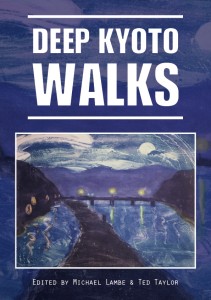I was delighted (and somewhat stunned) lately to learn that our book, Deep Kyoto: Walks, is being used as the basis of a university course here in Kyoto. The course at Kyoto Prefectural University is taught by Dr. Eleanor Yamaguchi and is called “欧米ã‹ã‚‰è¦‹ãŸäº¬éƒ½”, or “Kyoto viewed from the West”. Eleanor, who has used supplemental materials on the course, such as our Deep Kyoto: Walks videos, writes, “I couldn’t think of a better book to read.”

She continues,
“It’s been an excellent book for the course. The students were worried at first that they might not be able to read it, but with the extra materials like the YouTube videos and then looking at the websites of the different temples and shrines that get mentioned, they found that they could really get into the text. They learned a lot about Kyoto and about the international residents that live here, so it was perfect! We read through a couple of chapters each week and picked up on some of the English phrases and the content of each chapter… Some of the students and myself followed some of the routes in the book and I got them to do their own walks and do their own written pieces…
…Using a regular book rather than a typical textbook helps the students to gain the confidence and see for themselves that they can read a regular book. They didn’t think they could at first, but they did! They are only 1st year students, but by setting them up with the confidence to read a normal book in English, by the time it comes to writing their graduation theses in English in their 4th year, they will hopefully have the confidence to tackle any book they might want to use for references!”
Apparently the last class of the semester involved a trip to the Kyoto Botanical Gardens which is conveniently close to the university campus, and is also featured in a very fine chapter of the book by Izumi Texidor Hirai. Inspired by the text, the students did their own walk and wrote about it. And by sheer happy chance they bumped into Judith Clancy, who was good enough to supply our book’s epilogue.

Well, when I learned of Eleanor’s class, I was quite moved to think of it playing such a part in young people’s education. It was never something I expected, but somehow I feel it has made the whole enterprise worth while. It also strikes me as a very innovative and imaginative way of teaching a reading class: getting the students outdoors, writing their own original pieces, and really living the text! Many thanks, Eleanor. You are clearly an excellent teacher!
*****************************************************************
Text by Michael Lambe & Eleanor Yamaguchi. Images by Eleanor Yamaguchi. All rights reserved.

About Eleanor Yamaguchi
Eleanor Yamaguchi is an Associate Professor at Kyoto Prefectural University and a specialist in Japanese history and culture and UK-Japan relations. Her research covers the history of British-Japanese relations, the history of Japan (primarily late Edo/Meiji Periods), international relations and British history & culture (especially of the Victorian period). You can find her at her website, “Eleanor in Japan“, and on Twitter and Instagram.
About Deep Kyoto: Walks
Deep Kyoto: Walks is an independently produced anthology of meditative strolls, rambles, hikes and ambles around Japan’s ancient capital. All of the writers and artists involved in this project have lived and worked in Kyoto for many years and know it intimately. The book is in part a literary tribute to the city that they love and in part a tribute to the art of walking for its own sake. Deep Kyoto: Walks is available as a paperback or e-book from Amazon.com and Amazon.co.jp.
See also:
Kyoto Botanical Gardens by Izumi Texidor Hirai
On Foot in the Ancient Capital by Judith Clancy ~ An Exclusive Excerpt from Deep Kyoto: Walks






 The
The 






















